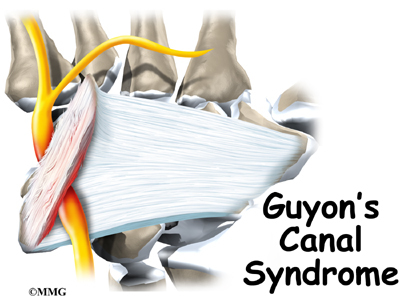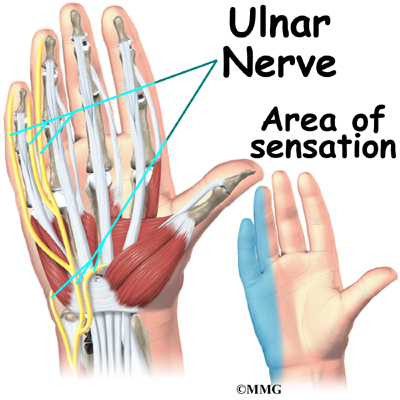
- An ulnar nerve entrapment at the wrist.
- This canal runs along the lower edge of the palm, on the little finger side of the hand.
- In the middle of the canal, the ulnar nerve splits into its two terminal branches (deep and superficial) that go on to the palm, ring and little fingers.
- Overuse of the wrist from heavy gripping, twisting, and repeated wrist and hand motions can cause symptoms.
- Working with the hand bent down and outward can squeeze the ulnar nerve.
- Constant pressure on the palm of the hand can produce symptoms.
- Common in cyclists and weight lifters from the pressure of gripping.
- It can also happen after running a jackhammer or when using crutches.
- Arthritis in the wrist bones and joints may eventually irritate and compress the ulnar nerve.
- A fractured hamate bone in the wrist can pinch the nerve inside Guyon's canal.
- This bone is sometimes fractured when golfers club the ground instead of the golf ball and when baseball players are batting.

 \
\Ulnar Claw
Symptoms:
- Three types depending on the level and type of compression involved.
- Type I involves compression in the proximal aspect of Guyon's canal. Here, motor weakness in all ulnar innervated hand intrinsics and typical ulnar distribution sensory loss that splits the ring finger are present. The dorsal aspect of the hand may not loose sensation in this type of syndrome.
- Type II is the most common syndrome type, and results from the compression of the ulnar nerve at the level of the lower wrist. With type II lesions, the sensory branch to the dorsal aspect of the hand and the innervation of the muscles of the base of the palm are spared.
- Type III is the least common, and involves pure sensory loss from compression of the superficial branch at the distal aspect of Guyon's canal. Therefore, in this type of lesion the symptoms mostly involve loss of sensation or feeling.
http://www.eorthopod.com/public/patient_education/6548/guyons_canal_syndrome.html
http://en.wikipedia.org/wiki/Ulnar_nerve_entrapment


No comments:
Post a Comment